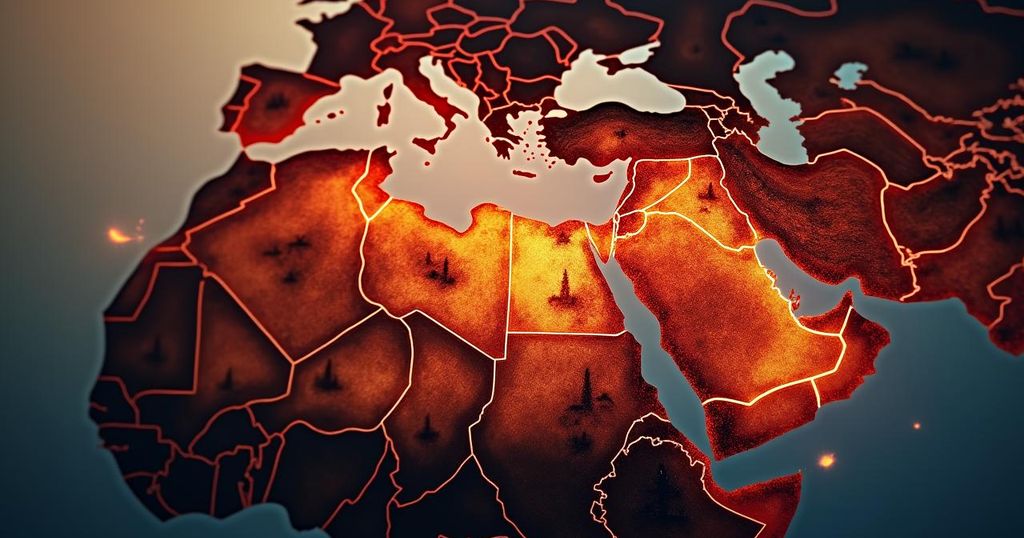The Middle East faces heightened violence, especially between Israel and Hezbollah following the recent Hamas attacks. Israel evacuated thousands from its northern border due to renewed rocket fire from Hezbollah. Despite successfully mitigating the Hamas threat, Israel’s focus on Hezbollah poses risks as the group remains a formidable adversary. Iranian involvement escalates tensions further, as Israel considers retaliatory actions against Iran’s nuclear capabilities. This situation signals a possible turning point for the region, with unpredictable consequences ahead.
The Middle East is currently experiencing a significant escalation of hostilities, particularly along the fault line between Israel and Hezbollah, following the recent uptick in violence. This resurgence of conflict was notably instigated by Hezbollah’s rocket strikes against Israel after the Hamas attacks on October 7, 2023, which prompted Israel to evacuate approximately 60,000 citizens from its northern borders to safeguard them from potential threats. The continuing skirmishes have made it unsafe for these individuals to return home. The context leading to this new front of conflict stems from Israel’s strategic focus on mitigating the military threat posed by Hamas in Gaza. Having notably diminished Hamas’s capabilities through major military strikes—resulting in substantial casualties and leadership decimation—Israel shifted its attention towards the north, specifically targeting Hezbollah. Israeli operations against Hezbollah have resulted in significant achievements, including targeted assassinations of key figures within the organization, which has bolstered Israel’s image as capable of conducting effective intelligence operations. Recent operations have included covert tactics followed by airstrikes and a ground incursion into Lebanon, although the extent and goals of this military ground engagement remain uncertain. While Israel aims to deter future Hezbollah attacks, it faces the complex reality that, despite recent gains, Hezbollah retains a formidable fighting force and continues to be a significant threat. As Hezbollah transitions to new leadership, its strategic choices will be critical; a retaliatory response to Israeli aggression could provoke stronger military responses from Israel, thus escalating tensions further. The international dynamic also complicates this situation, notably Iran’s growing involvement. Iran’s direct military provocations against Israel mark a potentially perilous shift and challenge the geopolitical landscape. This escalation could provide Israel with a rationale for retaliatory strikes against Iranian nuclear sites and military assets, actions that many within Israel perceive as necessary due to increasing frustrations with proxy conflicts. Israeli Prime Minister Benjamin Netanyahu even articulated, “When Iran is finally free—and that moment will come a lot sooner than people think—everything will be different.” However, while some advocate for direct action against Iran, the likelihood of regime change remains uncertain, as does the disposition of any potential successor government. The current Iranian regime has shown resilience and may intensify efforts to expand its military capabilities, including nuclear advancements. As the situation develops, it becomes increasingly evident that the Middle East might be approaching a significant turning point, though the direction of this shift remains unpredictable and fraught with risk.
The Middle East has long been characterized as a volatile region with numerous fault lines of conflict. Recently, an escalation of tensions has emerged particularly at the intersection of Israeli and Hezbollah interests, reminiscent of previous conflicts. The backdrop to these events includes a substantial military focus by Israel on Hamas, characterized by significant operations that have substantially weakened Hamas as a military entity, leading to a shift in Israeli focus to its northern border with Hezbollah. Moreover, Iran’s support of Hezbollah introduces another layer of complexity, as its actions directly influence regional stability and the potential for further conflict.
In conclusion, the dynamics unraveling in the Middle East highlight the fragility of the region’s geopolitical landscape. The escalating exchanges between Israel and Hezbollah, compounded by Iranian involvement, suggest an impending military confrontation with potentially wide-reaching implications. Israel’s strategic responses will be critical in shaping future interactions, not only for its own national security but for the broader stability of the Middle East.
Original Source: www.aspistrategist.org.au






